International Journal of Image, Graphics and Signal Processing @ijigsp
Статьи журнала - International Journal of Image, Graphics and Signal Processing
Все статьи: 1157
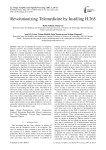
Revolutionizing Telemedicine by Instilling H.265
Статья научная
The aim of telemedicine system is to diagnose patients remotely; this includes healthcare provision to patients in far flung areas. The process of remote diagnosis is mainly dependent on bandwidths which are absolutely essential in terms of communications via the networks. Such communications have to be carefully monitored, because randomly sending data across the network and loading of packets as direct stream of cameras would result in chocking the bandwidth. Hence it is extremely important to make sure that the data is compressed so that there is minimum usage of bandwidth. But this has to be done in a way that maintains the quality at its best. This retention of good quality along with minimizing the usage of data is done by means of compression the streams obtained through cameras and then decompressing the data at the other end. This purpose was previously achieved by H.264 codec. Our major target was up gradation of the existing codec by introducing the latest; H.265. The Libde265 (Decoder) and the x265 (encoder) libraries have been used for the purpose of developing the H.265 codec. The H265 is an advanced codec, having better quality and ability to achieve far better compression than its predecessor. It has been shown through the algorithm and coding of H.265 that is has better compressing ability and the quality is maintained during the transmission of videos. This is highly desirable for the field of telemedicine as it can make improvements in providing healthcare services by easing the transmission of data in the form of videos from the patient end to the doctor’s end.
Бесплатно
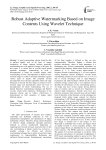
Robust Adaptive Watermarking Based on Image Contents Using Wavelet Technique
Статья научная
A good watermarking scheme should be able to perform equally well on all types of images irrespective of image contents because practically watermarking has to be applied to images of all types. In this paper, it is shown that in wavelet based spread spectrum technique, watermarking at level 1 decomposition is better for textured images while watermarking at level 2 decomposition is better for non-textured images to achieve maximum robustness against various types of attacks. The proposed wavelet decomposition level selection algorithm utilizes the edge histogram to classify the host image as textured or non-textured image and automatically selects the level of decomposition for robust watermarking. The use of Spread Spectrum watermarking technique and Bior6.8 wavelet, results better robustness. Performance of the proposed scheme and its relative effectiveness is demonstrated on both categories of images under different attacks.
Бесплатно
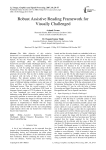
Robust Assistive Reading Framework for Visually Challenged
Статья научная
The Main objective of this assistive framework is to communicate the textual Information in the image captured by the Visually Challenged person as Speech, So that the Visually Challenged person can acquire knowledge about the surrounding. This framework can help Visually Challenged person to read books, magazine, warnings, instructions and various displays as well by taking their image along with the surrounding. Then the Optical Character Recognition (OCR) extracts and recognizes the text in the image and generates the text file. This text file is further converted to Speech with the help of Text to Speech (TTS) Synthesis. The inherent problem with the previous approach was if the acquired image is affected with the issues of different lighting conditions, noise and issue of Skew and Blur, as the image is captured by Visually Challenged person. Then the overall accuracy of the system was at stake due to inefficient OCR leads to improper Speech output of TTS Synthesis. In this paper we have introduced two more processes that are deblurring using Blind Deconvolution method and Pre-processing operation to remove the effect of noise and blur. Thus it prepares the image for efficient result of the framework for Visually Challenged. The proposed approach is implemented in Matlab with the image captured manually and taken from the internet and the result along with the OCR text file and corresponding output Speech shows that our framework is better than the previous framework.
Бесплатно
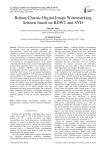
Robust Chaotic Digital Image Watermarking Scheme based on RDWT and SVD
Статья научная
In recent years chaos has received a great deal of attention from the researches specialized in communications, signal and image processing. The complexity property of the chaotic signal raised the idea of using such signals in secure communications. Digital image watermarking is a technique mainly developed for copyright protection and image authentication and it can be considered as one application area of the secure communication. In this study, a chaos based digital image watermarking algorithm based on redundant discrete wavelet transform (RDWT) and singular value decomposition (SVD) is proposed. To the best of our knowledge, there do not exist any digital watermarking scheme combining RDWT, SVD and chaos. Robustness and invisibility of the proposed method are improved by using the logistic mapping function to generate a chaotic image matrix serving as the watermark that is used to modify the singular values of the low frequency sub-band of the cover image obtained by applying RDWT. The method is shown to be robust against both the geometrical and image processing attacks and to provide better watermark concealment via computer simulations. Using a chaotic signal as the watermark allows the proposed scheme to meet the security requirements as well.
Бесплатно

Robust Dual Watermarking Scheme for Video Derived from Strategy Fusion
Статья научная
Current paper proposes a novel robust dual watermarking scheme that entrench a decipherable sample in the spatial domain and an invisible watermark in frequency domain of a color video. Visible watermark facilitate in the protection of publicly accessible data thus providing an imperative contribution for avoiding illegal duplication of data. The adaptive visible watermarking algorithm exploits various histogram features and not only embeds a visible watermark in the spatial domain but also facilitates its extraction and removal thus endowing with the facet of reconstruction of the video. For enhancing the robustness of the scheme and increasing the degree of protection of the watermark, invisible watermark is scrambled in parts and embedded in various frames of the video in DCT domain. These dual watermarks are embedded in host video. The robustness of the scheme is verified with various signal processing attacks, geometric attacks and video watermarking attacks like frame averaging. Reconstruction of the video helps the authorized subscribers to refurbish the original video.
Бесплатно
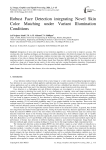
Robust Face Detection integrating Novel Skin Color Matching under Variant Illumination Conditions
Статья научная
Integration of skin color property in face detection algorithm is a recent trend to improve accuracy. The existing skin color matching techniques are illumination condition dependent, which directly impacts the face detection algorithm. In this study, a novel illumination condition invariant skin color matching method is proposed which is a composite of two rules to balance the high and low intensity facial images by individual rule. The proposed skin color matching method is incorporated into Haar Feature based Face Detection (HFFD) algorithm for face detection and is verified on a large set of images having variety of skin colors and also varying illumination intensities. Experimental results reveal the effectiveness and robustness of the proposed method outperforming other existing methods.
Бесплатно
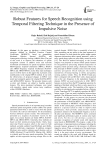
Статья научная
In this paper we introduce a robust feature extractor, dubbed as Modified Function Cepstral Coefficients (MODFCC), based on gammachirp filterbank, Relative Spectral (RASTA) and Autoregressive Moving-Average (ARMA) filter. The goal of this work is to improve the robustness of speech recognition systems in additive noise and real-time reverberant environments. In speech recognition systems Mel-Frequency Cepstral Coefficients (MFCC), RASTA and ARMA Frequency Cepstral Coefficients (RASTA-MFCC and ARMA-MFCC) are the three main techniques used. It will be shown in this paper that it presents some modifications to the original MFCC method. In our work the effectiveness of proposed changes to MFCC were tested and compared against the original RASTA-MFCC and ARMA-MFCC features. The prosodic features such as jitter and shimmer are added to baseline spectral features. The above-mentioned techniques were tested with impulsive signals under various noisy conditions within AURORA databases.
Бесплатно
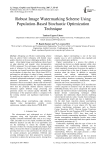
Robust Image Watermarking Scheme Using Population-Based Stochastic Optimization Technique
Статья научная
Designing an efficient watermarking scheme that can achieve better robustness with limited visual quality distortion is the most challenging problem. In this paper, robust digital image watermarking scheme based on edge detection and singular value decomposition (SVD) is proposed. Two sub-images, which are used as a point of reference for both watermark embedding and extracting, are formed from blocks that are selected based on the number of edges they have. Block based SVD is performed on sub-images to embed a binary watermark by modifying the singular value (S). A population-based stochastic optimization technique is employed to achieve enhanced performance by searching embedding parameters which can maintain a better trade-off between robustness and imperceptibility. The experimental results show that the proposed method achieves improved robustness against different image processing and geometric attacks for selected quality threshold. The performance of the proposed scheme is compared with the existing schemes and significant improvement is observed.
Бесплатно
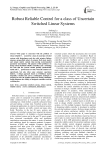
Robust Reliable Control for a class of Uncertain Switched Linear Systems
Статья научная
This paper is concerned with the problem of robust reliable H∞ control for a class of uncertain switched systems with disturbances and also with actuator failures among a prespecified subset of actuator. Both state matrix and output matrix contain time-varying norm-bounded parameter uncertainties. The purpose of this problem is to design robust feedback-reliable controllers and a switching law such that the systems remain globally quadratically stable and H∞ performance not only when all actuators are operational, but also when some actuators experience failures. A design approach based on LMI(linear matrix inequality) method and convex combination technique is proposed to solve the problem addressed. Finally, simulation results illustrate the validity of designed controllers and the switching law.
Бесплатно
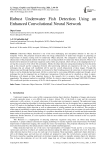
Robust Underwater Fish Detection Using an Enhanced Convolutional Neural Network
Статья научная
Underwater Object Detection is one of the most challenging and unexplored domains in this area of Computer Vision. The proposed research refines the image enhancement of under-water imagery by proposing an improvement of already existing tools for underwater Object detection. The comparative study clearly depicts the enhancement of the proposed method with respect to the existing methods for underwater object detection. Moreover, a framework for detection of underwater organisms such as fishes are proposed, which will act as the steppingstone for re- serving the ecosystem of the whole fish community. Mostly the object detection using deep learning has been the prime goal to this research and the comparison between other preexisting methods are compared at the end. As a result, techniques that are already well established will be used for overall enhancement of those images. Through this enhancement and through finding a healthy environment for their breeding ground, the extinction of selected species of fishes is can be diminished and decreased. All this is carried out by overcoming difficulties underwater through a novel technique that can be integrated into an Underwater Autonomous Vehicle and can be classified as robust in nature. Robustness will depend on three important factors in this research, first is accuracy, then fast and lastly being upgradeable. The proposed method is a modified VGGNet-16, which is trained using the ImageCLEF FISH_TS dataset. The overall result provides an accuracy of 96.4% which surpasses all its predecessors.
Бесплатно
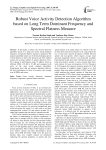
Статья научная
In this paper, a robust voice activity detection algorithm based on a long-term metric using dominant frequency and spectral flatness measure is proposed. The propose algorithm makes use of the discriminating power of both features to derive the decision rule. This method reduces the average number of speech detection errors. We evaluate its performance using 15 additive noises at different SNRs (-10 dB to 10 dB) and compared with some of the most recent standard algorithms. Experiments show that our propose algorithm achieves the best performance in terms of accuracy rate average over all SNRs and noises.
Бесплатно
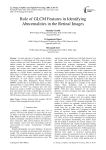
Role of GLCM Features in Identifying Abnormalities in the Retinal Images
Статья научная
Accurate detection of exudates in the diabetic retinal images is a challenging task. The images can have varying contrast and color characteristics. In this paper authors present the performance comparison of two feature extraction methods namely color intensity features and second order texture features based on GLCM. Authors have proposed and implemented new approach for GLCM feature calculation in which the input image is divided into number smaller blocks and GLCM features are computed on these blocks. The performance of each feature extraction method is evaluated using Back Propagation Neural Network (BPNN) classifier that is classifying the blocks as either abnormal block or normal block. With GLCM features, an accuracy of 76.6% was obtained and with color features an accuracy of 100% was obtained. It was found that color features are better in identifying true positives than GLCM based texture features. However use of GLCM features reduces the occurrence of false positives.
Бесплатно
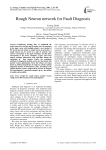
Rough Neuron network for Fault Diagnosis
Статья научная
Considering training time of traditional BP neural network is too long and it cannot solve the problems in the input vector with multiple-valued, a new method of BP neural network based on rough neuron is presented. A rough neuron can be viewed as a pair of neurons. One neuron corresponds to the upper boundary and the other corresponds to the lower boundary. Upper and lower neuron exchange information with each other during the calculation of their outputs. Firstly, the continuous attributes in diagnostic decision system are discretized with particle swarm optimization. Then, the reducts are found based on attribute dependence of rough set, and the optimal diagnostic decision is determined. Lastly, according to the optimal decision system, rough neuron network is designed for fault diagnosis. A practical example is given , the method is feasible and available.
Бесплатно
Статья научная
New area of image processing termed "digital image forensics" aims to gather quantifiable proof of a digital image's authenticity and place of origin. Detection of forgery images to look for copied and pasted portions; however, depending on whether the copied portion underwent post-processing before being transferred to another party, the detection method may differ. Zernike Moments and Scale-Invariant Feature Transform (SIFT) combined are unique techniques that aid in the identification of textured and smooth regions. But compared to SIFT separately, this combination is the slowest. So in the proposed work, Block based image division and SIFT based key point detection model is developed to detect forgery images. The gathered images are poor visual quality and various dimension, so it is resized and converter grayscale conversion. In addition, pixel values of images are improved using optimal Gaussian filter and adaptive histogram equalization which remove noise and blurring based on sigma value. Then, using the SIFT key point extraction algorithm to extract the image's key point and compute the feature vector of each key-points. In that using a block based matching technique to split the pre-images into blocks, and each blocks are diagonally subdivide. Length of the feature vector is computed using Zernike moments of each blocks. Both SIFT features and Zernike moments features are matched to identify the manipulated image from the given data. The proposed model provides 100% recall, 98.2% precision, and 99.09% F1_score. Thus provide the proposed model was effectively detects forgery image in the given data.
Бесплатно
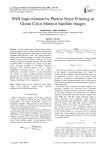
SNR Improvement by Photon Noise Filtering in Ocean Color Monitor Satellite Images
Статья научная
In high radiometric resolution electro optical image payloads of remote sensing satellites, photon noise dominates SNR performance. Photon noise is input signal dependent and difficult to filter. This paper proposes a photon noise filtering technique for Ocean Color Monitor (OCM) images. Existing filtering techniques are meant for object detection and handles images with poor SNR. As OCM SNR is on higher side, custom sigma filter based denoising technique is developed. Proposed technique first converts photon noise to signal independent Gaussian noise. For this variance stabilization, Anscombe transform is used. Simulations are carried on various images. Proposed technique provides 20- 50% reduction in overall as well count-wise RMSE. FFT analysis shows significant reduction in noise. Proposed technique is of low complexity.
Бесплатно
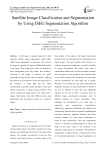
Satellite Image Classification and Segmentation by Using JSEG Segmentation Algorithm
Статья научная
In this paper, a adopted approach to fully automatic satellite image segmentation, called JSEG, "JPEG image segmentation" is presented. First colors in the image are quantized to represent differentiate regions in the image. Then image pixel colors are replaced by their corresponding color class labels, thus forming a class-map of the image. A criterion for “good” segmentation using this class-map is proposed. Applying the criterion to local windows in the class-map results in the “J-image”, in which high and low values corresponding to possible region boundaries and region centers, respectively. A region growing method is then used to segment the image based on the multi-scale J-images. Experiments show that JSEG provides good segmentation and classification results on a variety of images.
Бесплатно
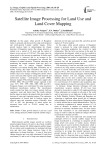
Satellite Image Processing for Land Use and Land Cover Mapping
Статья научная
In this paper, urban growth of Bangalore region is analyzed and discussed by using multi-temporal and multi-spectral Landsat satellite images. Urban growth analysis helps in understanding the change detection of Bangalore region. The change detection is studied over a period of 39 years and the region of interest covers an area of 2182 km2. The main cause for urban growth is the increase in population. In India, rapid urbanization is witnessed due to an increase in the population, continuous development has affected the existence of natural resources. Therefore observing and monitoring the natural resources (land use) plays an important role. To analyze changed detection, researcher’s use remote sensing data. Continuous use of remote sensing data helps researchers to analyze the change detection. The main objective of this study is to monitor land cover changes of Bangalore district which covers rural and urban regions using multi-temporal and multi-sensor Landsat - multi-spectral scanner (MSS), thematic mapper (TM), Enhanced Thematic mapper plus (ETM+) MSS, TM and ETM+ images captured in the years 1973, 1992, 1999, 2002, 2005, 2008 and 2011. Temporal changes were determined by using maximum likelihood classification method. The classification results contain four land cover classes namely, built-up, vegetation, water and barren land. The results indicate that the region is densely developed which has resulted in decrease of water and vegetation regions. The continuous transformation of barren land to built-up region has affected water and vegetation regions. Generally, from 1973 to 2011 the percentage of urban region has increased from 4.6% to 25.43%, mainly due to urbanization.
Бесплатно
Scale Adaptive Object Tracker with Occlusion Handling
Статья научная
Real-time object tracking is one of the most crucial tasks in the field of computer vision. Many different approaches have been proposed and implemented to track an object in a video sequence. One possible way is to use mean shift algorithm which is considered to be the simplest and satisfactorily efficient method to track objects despite few drawbacks. This paper proposes a different approach to solving two typical issues existing in tracking algorithms like mean shift: (1) adaptively estimating the scale of the object and (2) handling occlusions. The log likelihood function is used to extract object pixels and estimate the scale of the object. The Extreme learning machine is applied to train the radial basis function neural network to search for the object in case of occlusion or local convergence of mean shift. The experimental results show that the proposed algorithm can handle occlusion and estimate object scale effectively with less computational load making it suitable for real-time implementation.
Бесплатно
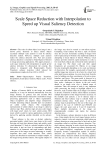
Scale Space Reduction with Interpolation to Speed up Visual Saliency Detection
Статья научная
The scale of salient object in an image is not a known priori, therefore to detect salient objects accurately multiple scale analysis is used by saliency detection models. However, multiple scale analysis makes the saliency detection slow. Fast and accurate saliency detection is essential to obtain Region of Interest in image processing applications. This paper proposes a scale space reduction with interpolation to speed up the saliency detection. To demonstrate the concept, this method is integrated with Hypercomplex Fourier Transform saliency detection which reduced the computational complexity from O(N) to O(N/2).
Бесплатно
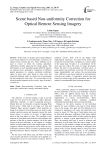
Scene based non-uniformity correction for optical remote sensing imagery
Статья научная
In this work, we propose and evaluate different scene based methods for non-uniformity corrections for optical remote sensing data sets. These methods can be used to correct or refine the existing radiometric calibrations, thereby improving the image quality. The performance of each algorithm against different datasets are analyzed and a quantitative comparison of different quality parameters viz. entropy, correlation coefficient, signal to noise ratio, peak signal to noise ratio and structural similarity index are carried out to recommend the best method for each scene. For a given data set, the selected method depends on the severity, type of terrain it covered, etc.
Бесплатно

